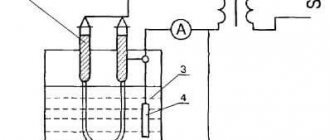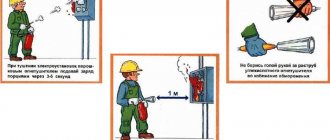Rostechnadzor explains: Personal protective equipment for electrical personnel
Question:
According to the list of personal protective equipment for electrical personnel as of 2022, at a facility where no production activities are carried out, electrical installations in which are up to 1000 Volts.
Answer: According to clause 2.2.21 of the Rules for the technical operation of consumer electrical installations, approved by order of the Ministry of Energy of Russia dated January 13, 2003 No. 6, registered with the Ministry of Justice of the Russian Federation on January 22, 2003, registration No. 4145, (hereinafter referred to as PTEEP) in the switchgear There must be electrical protective equipment and personal protective equipment (in accordance with the standards for equipping with protective equipment), PPE, protective fire-fighting and auxiliary equipment (sand, fire extinguishers) and means for providing first aid to victims of accidents.
The standards for equipping with protective equipment are regulated by Appendix 8 to the “Instructions for the use and testing of protective equipment used in electrical installations,” which was approved by Order of the Ministry of Energy of Russia dated June 30, 2003 No. 261. According to Appendix 8 of the above instructions, the Standards for equipping with protective equipment for switchgear up to 1000V is :
- Insulating rod (operational or universal) - according to local conditions;
- Voltage indicator - 2 pcs.;
- Insulating pliers - 1 pc.;
- Dielectric gloves - 2 pairs;
- Dielectric galoshes - 2 pairs;
- Dielectric carpet or insulating stand - depending on local conditions;
- Protective barriers, insulating pads, portable posters and safety signs - according to local conditions;
- Protective shields or glasses - 1 piece;
- Portable grounding - according to local conditions.
Acquisition standards are minimum and mandatory. Technical managers and workers responsible for electrical facilities are given the right, depending on local conditions, to increase the number and expand the range of protective equipment.
Supply of PPE to workers: employer’s responsibility and control over the fulfillment of its obligations
If the employer cannot provide the employee with the necessary PPE, then the employee has the right not to begin performing his work functions, while the company will be obliged to pay him a salary for downtime (clause 11 of the Appendix). Therefore, if an employer fails to comply with legal requirements to provide employees with personal protective equipment, he or she incurs direct economic losses.
The legislator makes corresponding amendments to the Labor Code. So, part 6 of Art. 216.1 of the draft Labor Code of the Russian Federation provides for the lawful refusal of an employee to perform work while maintaining wages. If employees are not provided with PPE, the employer faces a fine of at least 20 thousand rubles. up to 150 thousand rubles. in accordance with Art. 5.27.1 Code of Administrative Offenses of the Russian Federation.
If the failure to issue protective equipment led to an incident at work, the employer may be held criminally liable in accordance with Art. 143 of the Criminal Code of the Russian Federation.
Control over the employer’s fulfillment of obligations to equip employees with PPE can be exercised by:
- labor inspectorate - in accordance with Art. 353 Labor Code of the Russian Federation;
- trade unions - in accordance with Art. 370 Labor Code of the Russian Federation.
Providing electrical installations with protective equipment
According to the order of the Ministry of Energy of the Russian Federation dated 06/30/2003 261 On approval of the Instructions for the use and testing of protective equipment used in electrical installations, inventory protective equipment is distributed between facilities (electrical installations) and between mobile teams in accordance with the operating system, local conditions and acquisition standards (Appendix 8). Such distribution, indicating the storage locations of protective equipment, must be recorded in lists approved by the technical manager of the Organization or the employee responsible for electrical equipment.
Appendix 8. STANDARDS FOR PROTECTIVE EQUIPMENT
| Name of protective equipment | Quantity |
| Switchgears with voltages above 1000 V | |
| Insulating rod (operational or universal) | 2 pcs. for each voltage class |
| Voltage indicator | Same |
| Insulating pliers (in the absence of a universal rod) | 1 PC. for each voltage class (with appropriate fuses) |
| Dielectric gloves | At least 2 pairs |
| Dielectric boots (for outdoor switchgear) | 1 pair |
| Portable grounding | At least 2 for each voltage class |
| Protective fences (shields) | At least 2 pcs. |
| Safety posters and signs (portable) | According to local conditions |
| Insulating gas mask | 2 pcs. |
| Protective shields or glasses | 2 pcs. |
| Electrical installations with voltage 330 kV and above (optional) | |
| Individual shielding kits | According to local conditions, but not less than 1 |
| Shielding devices | According to local conditions |
| Switchgears with voltage up to 1000 V | |
| Insulating rod (operational or universal) | According to local conditions |
| Voltage indicator | 2 pcs. |
| Insulating pliers | 1 PC. |
| Dielectric gloves | Two pairs |
| Dielectric galoshes | Two pairs |
| Dielectric carpet or insulating pad | According to local conditions |
| Safety barriers, isolation pads, portable posters and safety signs | Same |
| Protective shields or glasses | 1 PC. |
| Portable grounding | According to local conditions |
| Transformer substations and distribution points of power distribution networks 6 - 20 kV (except package transformer substations, switchgear and mast substations) | |
| Insulating rod (operational or universal) | 1 PC. |
| Dielectric carpet or insulating pad | According to local conditions |
| Switchboards and control panels of power plants and substations, rooms (workplaces) of electricians on duty | |
| Voltage indicator | 1 PC. for each voltage class above 1000 V and 2 pcs. for voltage up to 1000 V |
| Insulating clamps for voltages above 1000 V (in the absence of a universal rod) | 1 PC. for each voltage class above 1000 V (with appropriate fuses) |
| Insulating clamps for voltages up to 1000 V | 1 PC. |
| Clamp meter | According to local conditions |
| Dielectric gloves | Two pairs |
| Dielectric galoshes | Two pairs |
| Insulating tool | 1 kit |
| Portable grounding | According to local conditions |
| Dielectric carpets and insulating pads | Same |
| Safety posters and signs (portable) | Same |
| Safety helmets | 1 PC. for every worker |
| Protective shields or glasses | 2 pcs. |
| Respirators | 2 pcs. |
| Operational field teams servicing substations and power distribution networks | |
| Insulating rods (operational or universal) | 1 PC. for each voltage class |
| Voltage indicators up to and above 1000 V | 2 pcs. for each voltage class |
| Individual voltage alarms | 1 PC. for every employee working on overhead lines |
| Insulating clamps for voltages above 1000 V (in the absence of a universal rod) | 1 PC. for each voltage class (with appropriate fuses) |
| Insulating clamps for voltages up to 1000 V | According to local conditions |
| Dielectric gloves | At least 2 pairs |
| Dielectric boots (for outdoor switchgear) | Two pairs |
| Insulating tool | 1 kit |
| Electrical clamps for voltages up to and above 1000 V | According to local conditions |
| Portable grounding | According to local conditions, but not less than 2 pcs. |
| Dielectric carpets and insulating pads | According to local conditions |
| Protective shields or glasses | 2 pcs. |
| Safety posters and signs (portable) | According to local conditions |
| Voltage indicator for checking phase coincidence | Same |
| Safety helmets | 1 PC. for every worker |
| Respirators | According to local conditions |
| Safety belt | Same |
| Operational maintenance team for substations, overhead and cable lines | |
| Insulating rods (operational or universal, measuring) | 1 PC. for each voltage class |
| Voltage indicator above 1000 V | 1 PC. for each voltage class |
| Voltage indicator up to 1000 V | 2 pcs. |
| Individual voltage detector | 1 PC. for every employee working on overhead lines |
| Portable grounding | According to local conditions, but not less than 2 pcs. |
| Voltage indicator for checking phase coincidence | According to local conditions |
| Dielectric gloves | At least 2 pairs |
| Dielectric bots | 1 pair |
| Safety belts and safety ropes | According to local conditions |
| Protective shields or glasses | Two pairs |
| Protective shield for electric welder | 1 PC. |
| Insulating tool | 2 sets |
| Dielectric carpets and insulating pads | According to local conditions |
| Safety posters and signs (portable) | Same |
| Respirators | Same |
| Safety helmets | 1 PC. for every worker |
| Mobile high-voltage laboratories | |
| Voltage indicator up to and above 1000 V | 1 PC. for each voltage class |
| Insulating rod (operational) | Same |
| Dielectric gloves | Two pairs |
| Dielectric bots | 1 pair |
| Safety poster set | |
| Dielectric carpet | At least 1 |
| Safety helmets | 1 PC. for every worker |
Notes.
1. Acquisition standards are minimum and mandatory. Technical managers and workers responsible for electrical facilities are given the right, depending on local conditions, to increase the number and expand the range of protective equipment.
2. When placing RU equipment up to and above 1000 V on different floors or in several rooms separated from each other by doors or other rooms, the specified number of protective equipment applies to the entire RU as a whole.
3. RUs of the same voltage, with no more than four in number, located within the same building and serviced by the same personnel, can be provided with one set of protective equipment, excluding protective fences and portable grounding.
4. Mast-mounted substations, package transformer substations and switchgear switchgear are equipped with protective equipment according to local conditions.
Inventory protective equipment is distributed between facilities (electrical installations) and among field teams in accordance with the operating system, local conditions and acquisition standards (Appendix 8). Such distribution, indicating the storage locations of protective equipment, must be recorded in lists approved by the technical manager of the Organization or the employee responsible for electrical equipment.
Additional
When working in electrical installations up to 1 kV, it is sufficient to use at least one additional protective device. The list includes the following items:
- Dielectric boots, galoshes and boots. The first two products can only be used when working in electrical installations up to 1000 Volts; in bots it is allowed to work at any voltage. These electrical protective equipment are needed to isolate the worker from the base on which he is standing.
- Dielectric mats and tracks. The purpose is similar to the previous version; it can be used in closed electrical devices of any voltage.
- Insulating stands. Prevents direct human contact with the floor. For voltages less than 1 kV, it is permissible to use electrical protective stands without porcelain insulators.
- Insulating caps, coverings and linings. Provide protection to humans from electric shock and prevent the occurrence of short circuits. An example of use is shown in the picture:
- Bars for leveling and transferring potential. They are used respectively in order to transfer the potential of the overhead line to the electrician’s workplace, as well as to equalize the potential between the individual shielding kit and large-sized devices for which the potential value is not constant.
- Dielectric stepladders and ladders. Allows you to protect a person from electric shock when working in electrical installations. The ladders are made of fiberglass, which isolates the worker from the base on which the ladder itself stands.
Finally, we recommend watching a useful video on the topic:
Overview of protective equipment used in EC
All listed electrical protective equipment in electrical installations up to 1000 V (both basic and additional) must be checked, as well as periodically tested for dielectric properties. We will definitely talk about this in future articles!
It will also be useful to read:
- Tests on the operation of electrical installations
- First aid rules for electric shock
- How to make an electrician's knife with your own hands
Dielectric mats
Dielectric mats are used as personal protective equipment against electric shock to workers. When working with any live electrical installations, safety rules require the presence of dielectric mats.
This product provides additional protection and is used together with insulating shoes, gloves, etc. However, the use of mats is especially necessary when the floor is wet or when working in close proximity to ungrounded metal stands.
Protective mats are made from special dielectric rubber, which is also very durable and elastic.
The dimensions of dielectric mats, according to established standards, can be as follows:
- length 500 – 1000 mm (with a permissible error of 10 mm) or 1000 – 8000 mm (with a permissible error of 30 mm),
- width 500 – 1200 mm (with permissible error 10 mm),
- thickness 6 mm (with a permissible error of 1 mm).
Basic devices
The main ones are those whose insulation can withstand the voltage of an electrical installation for a long time, as well as those devices that make it possible to touch current-carrying elements. They are tested under voltage taking into account the relevant electrical installation in which they are used.
The main devices for working with voltages of more than 1000 volts include: measuring clamps, rods, insulating means (platforms, stepladders, cables, rods). The main safety devices in installations up to 1000 volts are rods, insulating pliers, gloves, hand tools with insulating handles and voltage indicators.
Materials that absorb moisture (for example, wood) must be coated with a moisture-resistant composition and have a surface without scratches, peeling or splitting.
Types of dielectric mats
Depending on the operating conditions, dielectric mats are divided into two types:
- ordinary dielectric mats,
- oil and petrol resistant dielectric mats.
A conventional dielectric mat is designed for use in rooms with standard environmental conditions and can be used at temperatures from -15 to +40 degrees.
Oil and petrol resistant dielectric mats are designed for use in aggressive temperature conditions - the mat material is able to maintain its protective properties in the temperature range from -50 to +80 degrees. It is worth noting that at extremely high temperatures the service life of the mat is no more than 3000 hours.
Requirements for dielectric carpets
According to the established state standard, dielectric mats must meet a number of requirements. If the product to some extent does not comply with GOST, then its use may lead to undesirable consequences, therefore, before purchasing dielectric carpets, you should pay attention to its compliance with the standard.
Carpets must be made of rubber, the electrical strength of which should not be less than 10 kV/mm. The strength of the rubber must also withstand bending of the product by 180 degrees in two mutually perpendicular directions, without leaving cracks or creases. The physical and mechanical properties of the rubber used in the manufacture of dielectric mats are clearly stated in the relevant GOST.
All rugs must be one color and have a corrugated surface (reef depth 1-3 mm) to prevent slipping.
There should be no foreign inclusions, holes or cracks on the front side of the dielectric carpet. The standard allows the presence of small (no more than 1 mm in depth or height, and no more than 4 mm in diameter) shells or bubbles, but no more than 6 pieces per 1 meter of product length. Also, on the front side of the rug it is acceptable to have minor flaws in the relief pattern, its underpressing or different colors.
On the back of the mat, the presence of acceptable sizes of shells (maximum 1.5 mm in depth, 35 mm in length and 20 mm in width) or bubbles (maximum 1 mm in height and 5 mm in diameter) should also not exceed the number of 6 pieces per 1 meter length of carpet.
The standard also allows the presence of traces of anti-adhesive on both sides.
The test voltage that dielectric mats must withstand is 20 kV alternating current with a frequency of 50 Hz. The maximum permissible leakage current value for mats is 160 mA/sq.m.
Inspection and testing
Before using dielectric mats, products, like any other dielectric protective equipment, must first undergo a visual inspection for the absence of visible mechanical damage. If defects are found that are not allowed by the established standard, the mat should be replaced.
Tests of dielectric cows are carried out with alternating current with a frequency of 50±0.2 Hz at a temperature of 25±10 degrees and a relative humidity of 45-75%. Tests can be carried out in three ways: by pulling rugs between electrodes, by immersing products in a bath of water, by placing rugs between two flat electrodes.
Storing dielectric mats
Mats should be stored in dry rooms with air temperatures from 0 to +30 degrees. Products should not be exposed to direct sunlight, gasoline, oils and other aggressive substances, as well as any mechanical damage. It is prohibited to store products near heating appliances.
Storage of dielectric mats is permissible rolled into rolls, either one or several copies, or folded into bundles, excluding their deformation.
When storing products at subzero temperatures, unpacked products should rest for 24 hours at a temperature of + 20 degrees.
The guaranteed shelf life stated by the manufacturer is three years from the date of production of the product, and the service life is three years from the date of its use.
Additional electrical protective equipment above 1000 V
In addition to the basic equipment, additional protection is required for full and safe work as an electrician. Additional electrical protection measures over 1000 (V) include:
- Dielectric gloves, galoshes, mats, shield or stand, cap and pads. Gloves protect the worker’s hands from electric current. In electrical installations, dielectric overshoes are used to protect the worker from the current that may pass through the base. The rug performs the same function as galoshes. Particularly relevant if the floor is wet. A stand is required when working above 1000 (V). They protect against current, if there is one at the base. Dielectric caps and overlays are PPE that are used to prevent short circuits.
- Barbells for equalizing potential. Used to transfer stress.
- Stairs made of fiberglass. They are safe because no current passes through them.
What is included in the PPE kit
Home»Articles»What is included in the PPE kit
A set of personal protective equipment (PPE) is necessary to prevent the impact of negative factors on the skin, respiratory system and mucous membranes when working in adverse conditions, as well as to protect against contamination. The clothing and accessories included should be comfortable, provide freedom of movement and visibility, and ensure optimal air and heat exchange.
Electrical Hazards
A person at a distance cannot detect electrical voltage with his senses. There are three types of effects on the human body:
- thermal - burns, heating of parts of the body;
- chemical - decomposition of blood, lymph with a change in their properties;
- biological - muscles and tissues contract, even to the point of convulsions.
Protective means
Important! By affecting the muscles of the heart and lungs, electric current can disrupt the functioning of the respiratory organs and circulatory system, and lead to cardiac arrest. Two types of damage: Two types of damage:
Two types of damage:
- Electrical injuries expressed as damage to parts of the body - burns, damage to the iris of the eyes, metallization of the skin.
- Electric shocks are a general damage to the body.
Providing assistance in case of electric shock
The consequences of electric shock are determined by the magnitude of the current and voltage, the time of exposure and the individual characteristics of the person.
What is included in the PPE kit: general kit
The set of accessories and workwear depends on working conditions, the specifics of the profession, and weather conditions. Protecting the eyes and face, hands, head, respiratory organs, hearing, skin, safety kits for working at height, electrical, chemical and thermal protection kits will help ensure safety.
As a rule, the set is formed from:
- protective clothing that covers the body;
- masks, respirator or gas mask;
- shoes, gloves or mittens;
- hat, helmet or visor.
Depending on the conditions of use, they are subject to various requirements: resistance to chemical compounds or high temperatures, high density, tear resistance, high heat-saving properties, and others.
Insulating rods
The device consists of three parts: insulating, working and handle. The device is used on elements with passing current, or near them. The working elements can be clamps, tips and other structures, depending on the purpose. The universal head is made removable to perform different operations. It reliably fixes interchangeable devices. The rod becomes a monitoring device after attaching a voltage indicator to it. The number of links used on the insulating part may vary. Telescopic devices are convenient, but solid structures are also used. The weight load on the hand is standardized and selected so that one or two people can work.
Using rods, they check the quality of insulation, replace fuses, install various parts, carry out operations with disconnectors, measure electrical parameters, apply grounding, etc.
Using a barbell, you can free a person who has suffered from electric current.
The devices of various types of rods and the requirements for them are standardized.
In Fig. and a rod with a clamp is shown and all the components of the device are marked.
Rods used in electrical installations: a – operational; b – portable grounding
Portable grounding connections contain clamps for connection to live parts or wires (Fig. b). They can be removable or permanent.
Tests of rods are carried out under high voltage applied to their insulating parts. The parameters are presented in the table above. Voltage is applied between the working part and a removable electrode, which is temporarily attached near the stop between the handle and the insulating part (Fig. a).
Rod performance test diagram
The voltage value is regulated by an autotransformer installed at the input of the device (voltage regulator). The passing current is checked with a milliammeter, protected from overload using a spark gap (P) (Fig. b).
What is included in the minimum PPE kit?
A minimum set can be used when performing work associated with the risk of clothing contamination: repair, finishing, gardening. Here it is enough to provide employees with face masks, gloves and overalls or vests with reflective elements. When carrying out work at height, it is mandatory to use safety elements: slings, mounting belts, blocking devices.
When choosing certain means, you must be guided by what is included in the occupational safety and health protection equipment for each individual specialty, taking into account the season and weather conditions. To work outdoors or in unheated warehouses and workshops, it is necessary to create several sets for the warm and cold seasons. Winter workwear should provide good air exchange, retain heat, and freedom of movement.
Properly selected products will protect the life and health of employees and simplify work in difficult conditions of elevated temperatures, biological and chemical hazards.
Definition
Primary fire extinguishing means are devices, tools and materials designed to localize and (or) eliminate a fire at the initial stage (fire extinguishers, internal fire hydrant, water, sand, felt, asbestos cloth, bucket, shovel, etc.). These funds should always be ready and, as they say, at hand.
It would be more correct to call these means fire extinguishing agents , because... it is impossible and even life-threatening to resist a developing fire with their help.
Extinguishing a fire is the work of professional firefighters, but fighting a fire is feasible for non-specialists. It must be remembered that primary means are used to combat fire, but not fire.
Primary fire extinguishing agents
I will not be mistaken if I say that most often the fire supervision officers of the Ministry of Emergency Situations of Russia identify violations of fire safety requirements related to primary fire extinguishing means.
Such violations include the following:
- there are no primary fire extinguishing means;
- insufficient number of primary fire extinguishing agents;
- not the primary fire extinguishing agents that are needed;
- primary fire extinguishing means are faulty;
- there is no accounting of primary fire extinguishing means;
- The service life of the primary fire extinguishing equipment has expired.
So, what are primary fire extinguishing agents? These are means that can put out a fire or slow down its development at the very beginning, that is, during the first minutes. The purpose of primary fire extinguishing agents depends on their type, but all of them are necessary to extinguish the initial stage of a fire. Most often, fire extinguishers are understood as primary means, but this is not entirely true.
Benefits of PPE from
We cooperate only with trusted manufacturers who have proven themselves in the market. This is why the products in our catalog are different:
- strength;
- durability;
- wear resistance;
- resistance to external influences;
- hypoallergenic;
- environmental friendliness;
- at an affordable price.
The presented sets are easy to clean, resistant to the external environment, and made of modern high-quality materials. From us you can buy PPE for a wide range of work, including highly targeted and specific ones. All products are certified and have undergone thorough safety control. Find out more from our consultants.
Minimum set of PPE for electrical installations up to 1000V
Catalog
- Electrical protection means Portable grounding for overhead lines
- Portable grounding for switchgear
- Dielectric tool
- Sets of protective equipment for electrical installations - KSZ
- Releasing devices (UR)
- Voltage alarms
- Individual protection means
- Units and parts
- High voltage indicators
- Voltage indicators up to 1000V
- Cable damage indicator
- Devices for working on lines
- Operating insulating rods
- Electrical Safety Posters
- Dielectric ladders
- Powder fire extinguishers
- Modular grounding
- Current clamps
- Pump control units
- Model pressure gauges MO
Set of protection equipment for switchgear voltages up to 1000V and above
We are often asked: “What protection means should be equipped with switchgears (electrical installations/panelboard/substations) up to 1000V and above 1000V?”
The selection of the necessary electrical protective equipment, means of protection from high-intensity electric fields and personal protective equipment is regulated by these rules, “Safety Rules for the Operation of Electrical Installations”, “Safety Rules for the Operation of Consumer Electrical Installations”, “Sanitary Standards for the Performance of Work in Conditions of Exposure to Electric Fields of Industrial frequency", "Guidelines for the protection of personnel servicing switchgears and overhead power lines of alternating current voltages of 400, 500 and 750 kV from exposure to electric fields" and other relevant regulatory and technical documents taking into account local conditions.
When choosing specific types of personal protective equipment, you should use the appropriate PPE catalogs and recommendations for their use.
According to Appendix 8 of the order of the Ministry of Energy of the Russian Federation dated 06/30/2003 261 on approval of the Instructions for the use and testing of protective equipment used in electrical installations, our company offers two ready-made sets of electrical protective equipment in electrical installations up to 1000V and over 1000V (including transformer substations, switchboards and control panels):
Kit for switchgears with voltage up to 1000V (KSZ-1)
| Name of protective equipment | Quantity |
| Insulating rod SHO-1 or universal SHOU-1 | 2 pcs. |
| Low voltage indicator UNNU-25-1000 (or UNNO-1M) | 2 pcs. |
| Insulating pliers KVP-2 (or KI-1000) | 2 pcs. |
| Dielectric gloves | Two pairs |
| Dielectric bots | Two pairs |
| Set of posters (7 pcs. or 13 pcs.) | 1 set |
| Safety glasses | 1 PC. |
| Dielectric rug (size at customer’s discretion) | 1 PC. |
| Portable grounding ZPP-1/3 with section. 16mm2 | 1 PC. |
| Testing of PPE and verification of protective equipment with a protocol for the organization | 1 PC. |
Kit for switchgears with voltages above 1000V (KSZ-2)
| Name of protective equipment | Quantity |
| Insulating rod SHO-15 or universal SHOU-15 | 2 pcs. |
| High voltage indicator UVNSZ 6-10 | 2 pcs. |
| Clamp meter (multimeter) | 2 pcs. |
| Dielectric gloves | Two pairs |
| Dielectric bots | Two pairs |
| Set of posters (7 pcs. or 13 pcs.) | 1 set |
| Safety glasses | 1 PC. |
| Dielectric rug 750x750 | 1 PC. |
| Portable grounding ZPP-15-3/1 with section. 25mm2 | 1 PC. |
| Testing of PPE and verification of protective equipment with a protocol for the organization | 1 PC. |
Notes: 1. Picking standards are minimum and mandatory. Technical managers and workers responsible for electrical facilities are given the right, depending on local conditions, to increase the number and expand the range of protective equipment. 2. When placing RU equipment up to and above 1000 V on different floors or in several rooms separated from each other by doors or other rooms, the specified number of protective equipment applies to the entire RU as a whole. 3. RUs of the same voltage, with no more than four in number, located within the same building and serviced by the same personnel, can be provided with one set of protective equipment, excluding protective fences and portable grounding. 4. Mast-mounted substations, package transformer substations and switchgear switchgear are equipped with protective equipment according to local conditions.
Before putting the protective equipment into operation, it is necessary to verify and carry out tests; the frequency with which this procedure is carried out regularly is indicated below. Rugs and coasters are not tested, but they are subject to inspection once a year or once every 2 years, respectively. In general, before each use of protective equipment, it is necessary to conduct a visual inspection for possible damage.
| Name of the protective equipment | Verification frequency |
| Insulating rods | Once every 24 months |
| Insulating pliers | Once every 24 months |
| Clamp meter | Once every 24 months |
| Voltage indicators up to and above 1000 V | Once every 12 months |
| Dielectric gloves | Once every 6 months |
| Dielectric galoshes | Once every 12 months |
| Dielectric boots | Once every 36 months |
| Hand insulating tool | Once every 12 months |
| Claws and manholes | Once every 12 months |
| Safety belts | Once every 6 months |
>Useful materials
Insulating pliers
In accordance with electrical safety requirements, work related to the replacement of equipment such as fuses or insulating strips must be carried out using insulating pliers.
This device has good protection indicators and can be used at high voltages up to 35 kV.
The device itself is divided into three parts:
- lever;
- insulating part;
- working part.
If the working part of the pliers is made of metal, then, as a rule, it should not be very large, since smaller sizes help to avoid unauthorized contact with live parts, which can lead to a short circuit. The dimensions of the insulating part of this device are not standardized. The exception is those clamps that are used in installations above 1 kV, since their size is directly proportional to the voltage.
Insulating pliers are designed for replacing fuses, removing and installing insulating strips, etc. in electrical installations
It is worth noting that, according to safety requirements, this electrical protective agent can only be used in dry weather. There are no restrictions on the use of insulating clamps inside a building.
This tool must be operated with dielectric gloves, and when dismantling the fuse, the worker must have special safety glasses with him. Like any other means of protection against electric shock, dielectric clamps must undergo timely testing for suitability for use.
According to the requirements of the PUE, this electrical protective device must be tested once every 2 years.
Requirements for electrical rooms
According to generally accepted norms and standards, electrical panel equipment must be placed in specially designated rooms. Of course, it is permissible to place some cabinets outdoors, on a support or on the outside of a building, as well as in vestibules or on floors.
For all other panels, panel rooms are provided, which are usually small in size and contain all the necessary devices for the safe and uninterrupted functioning of the building’s electrical systems. According to the established rules, several requirements are put forward to them, which should be taken into account to avoid loss of life and damage to property.
Basic conditions for creating an electrical room
The electrical panel room must have natural ventilation and good lighting in case of a power outage. The ambient temperature should not fall below +5 degrees. It is strictly forbidden to place the panel room under spaces with high levels of humidity, for example, under showers, toilets, steam rooms or kitchens. They can have a detrimental effect on the insulation and casing of modules, destroying wiring and promoting corrosion. It is under no circumstances recommended to lay any pipes through the technical room, except heating pipes that promote heating.
The control room can be equipped with fire doors, but it is important to remember that they must open outward and have self-locking locks. Just in case, it is worth installing emergency electric lighting in the room, which will function even if the building loses power. To do this, you can place a shield with an automatic transfer switch or other similar equipment.
When equipping an electrical panel, do not forget that the height of the panels should not be higher than two meters from the floor level. Escape routes and all necessary passages must strictly comply with GOST standards and fire safety regulations.
Only qualified specialists with the appropriate permit should carry out installation and repair work in such premises. Only they can install the equipment necessary for the operation of the electrical network, mount the main distribution boards, ASUs and distribution points.
For safety, it is imperative to provide for the presence of a grounding loop, and also to exclude the use of multi-core cables without lugs and plastic bushings. In addition, placing power and low-current networks in the same panel is not allowed.
Compliance with all of the above criteria allows you to reduce the risk of accidents, save the lives of operating personnel and prevent damage to property. Following GOST standards will make the operation of any facility safe and efficient, regardless of its purpose. These rules are equally suitable for arranging switchboards for large industrial enterprises or public organizations, kindergartens, schools, shopping centers and office buildings. Moreover, it does not matter at all what equipment you are going to place in them: main switchboards, input distribution devices, control and automation panels, or other installations. It is important to remember that any troubleshooting in switchboards, whether diagnosing faults or restoring logical circuits, must be carried out with the power turned off and the entire system completely stopped.
>News
TopEng.ru/Energy Dictionary/
Basic requirements for electrical rooms
electrical panel with references to the standards.
As a rule, electrical switchboards should be located on the ground floor of the building; they can be placed in a dry basement. In areas prone to flooding, they should be installed above the flood level.
Electrical switchboards are not allowed to be located directly under restrooms, bathrooms, shower rooms, food service kitchens and other rooms with wet processes. It is also prohibited to place them under and above living rooms.
In an apartment building, the electrical panel is located under the kitchen of the apartments.
Entrances to electrical switchboards must be made directly from the street or from floor-by-floor non-apartment corridors.
Fire doors of the 2nd type (EI 30), opening outwards, must be installed in electrical control rooms. Doors must have self-locking locks that can be opened without a key from the inside of the room. The width of the doors must be at least 0.75 m, height at least 1.9 m.
In terms of explosion and fire hazard, electrical panels belong to category B4
Electrical switchboard rooms should be separated by fire walls and ceilings, their type depends on the functional fire hazard class of the facility (SP 4.13130 clause 5.2.6, clause 5.4.2, clause 5.6.4)
Laying air ducts and pipelines through electrical switchboards is prohibited.
Such premises must be equipped with natural ventilation. They must maintain a temperature of at least 5 °C.
The electrical control room must be equipped with working, emergency (backup) and repair lighting. The illumination level is 50 Lux on the floor and 200 Lux in the equipment area. For repair lighting, a socket with a voltage of up to 50V must be provided.
For multi-apartment residential buildings, the optimal size of the electrical panel is 3x5m.
The clear passage width must be at least 0.8 m, the clear passage height must be at least 1.9 m.
The floor covering must be such that there is no formation of cement dust.
The electrical room must contain electrical protective equipment and personal protective equipment (in accordance with the standards for equipping with protective equipment), fire protection and auxiliary equipment (sand, fire extinguishers) and means for providing first aid to victims of accidents.










